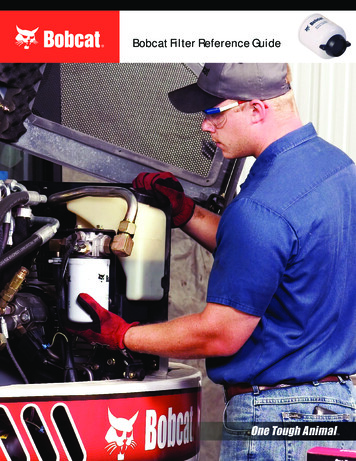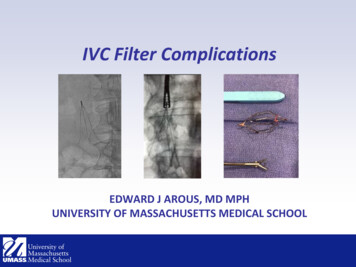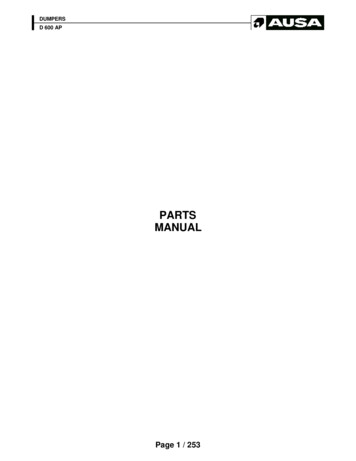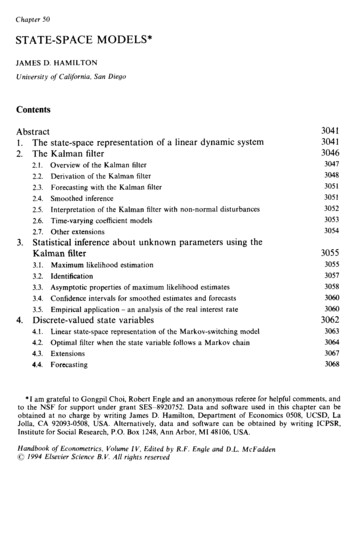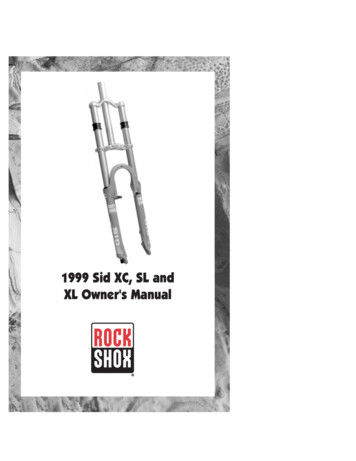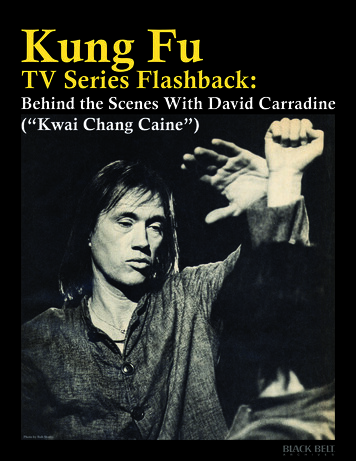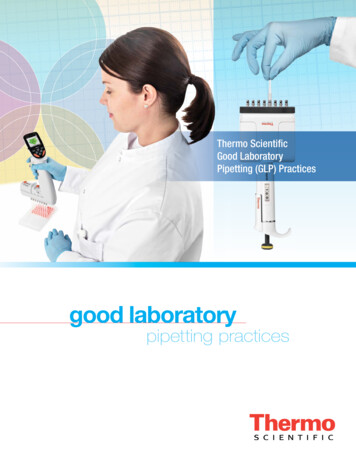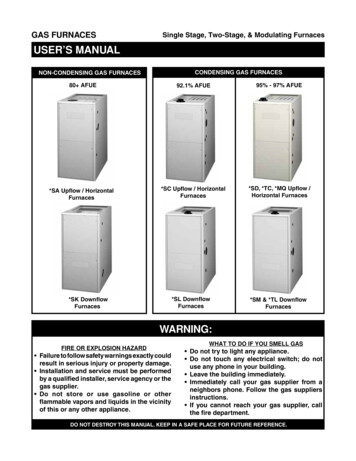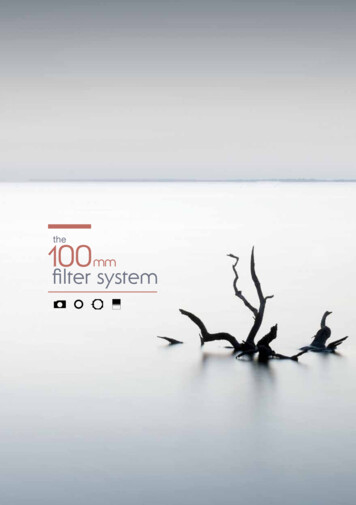
Transcription
the100mmfilter system
23IntroductionContentsThere is a reason why LEE Filters has established aworldwide reputation for quality that is second to none.It is because every filter that leaves the factory has beenhandmade and inspected by one of our highly skilled staff,who ensure it meets our exacting standards.This rigorous process and attentionto detail at every level means thatLEE Filters has, since its inception in1978, been assured of its positionas the benchmark in camera filters– its status backed up by the manyphotographers worldwide whocontinue to recommend its productsfor both film and digital photography.Despite the wide availability of imagemanipulation programmes, digitalphotographers are increasinglyrecognising the benefits of refiningthe image and ensuring it is correctin-camera. The less work required atthe computer, the more time can bespent in the field.Any system has to start with thefundamentals, and with LEE Filters itis no different.At the core of any photographer’skit – whether amateur or professional,and whether shooting film or digital– is the filter holder. Deceptivelysimple and highly versatile, it is allany photographer needs to ensureaccurate and creative results.A long-established history ofsupplying filters to the film, televisionand theatre lighting markets,where the demands are stringentand exacting, gives LEE Filters thefreedom to apply the same principlesto its photographic products.It’s quite simple. Inferior filters resultin a loss of picture quality.LEE Filters, however, offersthe assurance that its productscomplement the standards set bycamera and lens manufacturers.Compromising picture quality is notan option.Front cover photography by Jonathan Chritchley tting startedThe 100mm SystemFilter holdersAdaptor ringsLens hoodsFiltersNeutral density filtersThe Big stopperPolarising filterResin sets363741424448505254Soft focus filtersSingle effects filtersTechnical filtersPolyester technical setsColour controlFilters for black & whitephotographyAccessoriesLighting filtersIndex
23IntroductionContentsThere is a reason why LEE Filters has established aworldwide reputation for quality that is second to none.It is because every filter that leaves the factory has beenhandmade and inspected by one of our highly skilled staff,who ensure it meets our exacting standards.This rigorous process and attentionto detail at every level means thatLEE Filters has, since its inception in1978, been assured of its positionas the benchmark in camera filters– its status backed up by the manyphotographers worldwide whocontinue to recommend its productsfor both film and digital photography.Despite the wide availability of imagemanipulation programmes, digitalphotographers are increasinglyrecognising the benefits of refiningthe image and ensuring it is correctin-camera. The less work required atthe computer, the more time can bespent in the field.Any system has to start with thefundamentals, and with LEE Filters itis no different.At the core of any photographer’skit – whether amateur or professional,and whether shooting film or digital– is the filter holder. Deceptivelysimple and highly versatile, it is allany photographer needs to ensureaccurate and creative results.A long-established history ofsupplying filters to the film, televisionand theatre lighting markets,where the demands are stringentand exacting, gives LEE Filters thefreedom to apply the same principlesto its photographic products.It’s quite simple. Inferior filters resultin a loss of picture quality.LEE Filters, however, offersthe assurance that its productscomplement the standards set bycamera and lens manufacturers.Compromising picture quality is notan option.Front cover photography by Jonathan Chritchley tting startedThe 100mm SystemFilter holdersAdaptor ringsLens hoodsFiltersNeutral density filtersThe Big stopperPolarising filterResin sets363741424448505254Soft focus filtersSingle effects filtersTechnical filtersPolyester technical setsColour controlFilters for black & whitephotographyAccessoriesLighting filtersIndex
45Getting StartedDigital SLR Starter KitIf you’re new to the LEE Filterssystem, this is what you’ll need toset you on your way. The Digital SLRStarter Kit comes with the filter holderalready assembled, so all you need todo is to slot in either the 0.6 neutraldensity (ND) grad, or the ProGlass0.6 standard ND filter, clip it to youradaptor ring* and start shooting.The ProGlass ND filter is designedto cut out more infrared and UVlight than the standard resin version.The result? A cleaner, crisper result,with fewer colour aberrations whenshooting in challenging light.Starter kitA cleaning cloth ensures the filtersremain free of dust, and the kit is allpacked in a neat triple pouch.Your Digital SLR Starter Kit includes: Filter holder ProGlass 0.6 ND standard(100 x 100mm) 0.6 ND hard grad (100 x 150mm) Cleaning cloth Triple pouch*Adaptor Ring not included, needs to bepurchased separately.Like the Digital SLR Starter Kit, aready assembled filter holder comesas standard with this kit. However,the main difference lies in theinclusion of a Coral 3 graduated filter,which has enough tone to be usedboth as a grad or an all over warmup filter. Also included in the kit is a0.6 ND hard grad, cleaning cloth andtriple pouch.Your Starter Kit includes: Filter holder0.6 ND hard grad (100 x 150mm)Coral 3 hard grad (100 x 150mm)Cleaning clothTriple pouch*Adaptor Ring not included, needs to bepurchased separately.Foundation kitThe Foundation Kit – the basic filterholder – attaches to the camera’slens via an adaptor ring. The holderis suitable for between one and fourfilters and is compatible with anycamera format, whether film or digital.Adaptor ring: Screws onto lensHolder: Clips onto adaptor ringFilters: Slot into holder
45Getting StartedDigital SLR Starter KitIf you’re new to the LEE Filterssystem, this is what you’ll need toset you on your way. The Digital SLRStarter Kit comes with the filter holderalready assembled, so all you need todo is to slot in either the 0.6 neutraldensity (ND) grad, or the ProGlass0.6 standard ND filter, clip it to youradaptor ring* and start shooting.The ProGlass ND filter is designedto cut out more infrared and UVlight than the standard resin version.The result? A cleaner, crisper result,with fewer colour aberrations whenshooting in challenging light.Starter kitA cleaning cloth ensures the filtersremain free of dust, and the kit is allpacked in a neat triple pouch.Your Digital SLR Starter Kit includes: Filter holder ProGlass 0.6 ND standard(100 x 100mm) 0.6 ND hard grad (100 x 150mm) Cleaning cloth Triple pouch*Adaptor Ring not included, needs to bepurchased separately.Like the Digital SLR Starter Kit, aready assembled filter holder comesas standard with this kit. However,the main difference lies in theinclusion of a Coral 3 graduated filter,which has enough tone to be usedboth as a grad or an all over warmup filter. Also included in the kit is a0.6 ND hard grad, cleaning cloth andtriple pouch.Your Starter Kit includes: Filter holder0.6 ND hard grad (100 x 150mm)Coral 3 hard grad (100 x 150mm)Cleaning clothTriple pouch*Adaptor Ring not included, needs to bepurchased separately.Foundation kitThe Foundation Kit – the basic filterholder – attaches to the camera’slens via an adaptor ring. The holderis suitable for between one and fourfilters and is compatible with anycamera format, whether film or digital.Adaptor ring: Screws onto lensHolder: Clips onto adaptor ringFilters: Slot into holder
67Getting StartedNeutral density filtersPolariserThere are two types of neutral density filter: graduated and standard. Both aretypically available in strengths of 0.3, 0.6 and 0.9 – equating to one, two and threestops respectively.When light bounces off a flat,non-metallic surface – such as glassor water – it becomes polarised.This means that all the reflectedlightwaves vibrate in the same plane.The result is glare, which createsextremes of contrast, is difficult tocontrol, and generally confuses thescene. A polarising filter cuts outthis glare, removes reflections andresults in more saturated colours.The strength of the polarised effectdepends on the rotation of thepolarising filter.Neutral density filters have no impact on colour balance, and should not beconfused with grey filters. They can be used alone or in combination with othertypes of filter – a warm-up, for example.Polarising filters are available in twotypes: linear and circular. See page 26for a full explanation of these terms.Neutral density graduated filtersNeutral density standard filtersThe neutral density graduated filter(also known as an ND grad) is usedto balance the exposure within ascene – typically when the sky isbrighter than the foreground.The only difference between NDgrads and ND standards is that thestandard is coated evenly across theentire filter, rather than partially.ND grads can be used bothhorizontally and at an angle,and more than one can bestacked on top of the other, forextreme variations in exposureacross the composition.The ND standard is used in two mainways: to reduce the quantity of lighthitting the camera’s sensor, or film,permitting longer shutter speeds; andto reduce the sensitivity of a sensor ina DSLR that has a high minimum ISOsetting (ISO 200 or above).When first using ND standards,experiment with slow shutterspeeds in order to learnexactly their impact on movingsubjects, such as clouds, wateror windblown leaves.One of the main functions of thepolariser is to cut polarised lightfrom blue skies. This results inan increase in contrast betweenthe sky and any white cloudsin the scene. The effect is at itsstrongest when the filter is usedat a 90-degree angle to the sun.Universal hoodA versatile accessory, the UniversalHood shades lenses on any camerafrom DLSR or film SLR to mediumformat. It comes assembled withtwo filter slots, but can also beconfigured to take different filtercombinations. It allows the effectsof flare to be controlled, leaving thephotographer to concentrate oncreative composition.
67Getting StartedNeutral density filtersPolariserThere are two types of neutral density filter: graduated and standard. Both aretypically available in strengths of 0.3, 0.6 and 0.9 – equating to one, two and threestops respectively.When light bounces off a flat,non-metallic surface – such as glassor water – it becomes polarised.This means that all the reflectedlightwaves vibrate in the same plane.The result is glare, which createsextremes of contrast, is difficult tocontrol, and generally confuses thescene. A polarising filter cuts outthis glare, removes reflections andresults in more saturated colours.The strength of the polarised effectdepends on the rotation of thepolarising filter.Neutral density filters have no impact on colour balance, and should not beconfused with grey filters. They can be used alone or in combination with othertypes of filter – a warm-up, for example.Polarising filters are available in twotypes: linear and circular. See page 26for a full explanation of these terms.Neutral density graduated filtersNeutral density standard filtersThe neutral density graduated filter(also known as an ND grad) is usedto balance the exposure within ascene – typically when the sky isbrighter than the foreground.The only difference between NDgrads and ND standards is that thestandard is coated evenly across theentire filter, rather than partially.ND grads can be used bothhorizontally and at an angle,and more than one can bestacked on top of the other, forextreme variations in exposureacross the composition.The ND standard is used in two mainways: to reduce the quantity of lighthitting the camera’s sensor, or film,permitting longer shutter speeds; andto reduce the sensitivity of a sensor ina DSLR that has a high minimum ISOsetting (ISO 200 or above).When first using ND standards,experiment with slow shutterspeeds in order to learnexactly their impact on movingsubjects, such as clouds, wateror windblown leaves.One of the main functions of thepolariser is to cut polarised lightfrom blue skies. This results inan increase in contrast betweenthe sky and any white cloudsin the scene. The effect is at itsstrongest when the filter is usedat a 90-degree angle to the sun.Universal hoodA versatile accessory, the UniversalHood shades lenses on any camerafrom DLSR or film SLR to mediumformat. It comes assembled withtwo filter slots, but can also beconfigured to take different filtercombinations. It allows the effectsof flare to be controlled, leaving thephotographer to concentrate oncreative composition.
89Getting StartedThe 100mm filter systemLearn the best wayto use your filtersInspirationand educationWhether you shoot film or digital,Inspiring Professionals and InspiringProfessionals 2 are the only guidesto using filters you’ll ever need.Produced by LEE Filters, withcontributions from professionals atthe top of their field, these hardbackbooks feature not only some of thefinest landscape and architecturalphotography, but also numeroushints and tips from the likes ofJoe Cornish, Charlie Waite, DavidWard, Mark Denton, John Gravett,David Noton, Jeremy Walker, PaulGallagher and Tom Mackie.David Noton has received worldwideacclaim for his landscape andtravel photography, and his DVD,Chasing the Light, brings togetherhis knowledge and expertise onthe subject. Covering topics suchas location, light, composition andpostproduction, not to mentionnumerous hands-on tutorials atinspiring locations, Chasing the Lightdemonstrates how a photographer’sdevelopment evolves when bothartistry and technique are balanced.With Landscape in Mind (DVD)is a feature length documentaryfilm from Light & Land, producedby Environmental Films. It followsleading landscape photographerJoe Cornish on a photographic roadtrip across the north of England. Joemakes a journey from coast to coastacross the north of England tracinga path from the industrial mouth ofthe river Tees, through the stark andbeautiful limestone scenery of theYorkshire Dales, to the Lake District,arguably England’s most romanticand spectacular landscape. Alongthe way Joe reveals the aesthetic andphysical challenges these beautifullandscapes offer a photographer.At the core of the LEE Filters system is the holder, which can beconstructed with up to four slots, and is intended to be versatileand straightforward to use, freeing up the photographer toconcentrate on taking the picture. The holder is designed to becompatible with 100mm filters – LEE Filters’ standard width.To fit the holder to the lens, an adaptor ring is required. There aretwo types of LEE Filter adaptor ring: one for general use, and onefor wideangle lenses.1012Holder versatilityFoundation kit1416Adaptor ringsLens hoods
89Getting StartedThe 100mm filter systemLearn the best wayto use your filtersInspirationand educationWhether you shoot film or digital,Inspiring Professionals and InspiringProfessionals 2 are the only guidesto using filters you’ll ever need.Produced by LEE Filters, withcontributions from professionals atthe top of their field, these hardbackbooks feature not only some of thefinest landscape and architecturalphotography, but also numeroushints and tips from the likes ofJoe Cornish, Charlie Waite, DavidWard, Mark Denton, John Gravett,David Noton, Jeremy Walker, PaulGallagher and Tom Mackie.David Noton has received worldwideacclaim for his landscape andtravel photography, and his DVD,Chasing the Light, brings togetherhis knowledge and expertise onthe subject. Covering topics suchas location, light, composition andpostproduction, not to mentionnumerous hands-on tutorials atinspiring locations, Chasing the Lightdemonstrates how a photographer’sdevelopment evolves when bothartistry and technique are balanced.With Landscape in Mind (DVD)is a feature length documentaryfilm from Light & Land, producedby Environmental Films. It followsleading landscape photographerJoe Cornish on a photographic roadtrip across the north of England. Joemakes a journey from coast to coastacross the north of England tracinga path from the industrial mouth ofthe river Tees, through the stark andbeautiful limestone scenery of theYorkshire Dales, to the Lake District,arguably England’s most romanticand spectacular landscape. Alongthe way Joe reveals the aesthetic andphysical challenges these beautifullandscapes offer a photographer.At the core of the LEE Filters system is the holder, which can beconstructed with up to four slots, and is intended to be versatileand straightforward to use, freeing up the photographer toconcentrate on taking the picture. The holder is designed to becompatible with 100mm filters – LEE Filters’ standard width.To fit the holder to the lens, an adaptor ring is required. There aretwo types of LEE Filter adaptor ring: one for general use, and onefor wideangle lenses.1012Holder versatilityFoundation kit1416Adaptor ringsLens hoods
1011Holder versatilityTo position the graduation line slide the filter up and down in the holder.The LEE Filters holder has beendesigned with almost everyphotographic eventuality andcombination in mind. Up to fourfilters can be used in one holder.A combination of different types offilter, such as neutral density andwarm-up if shooting colour, whetherfilm or digital. Or red and neutraldensity standard (to darken blueskies and slow down the exposure) ifshooting with black & white film, forexample.Crucially, once fitted to the adaptorring, the holder can be rotated to anyangle. This permits the photographerto balance the exposure even whenthe brightest areas fall, say, within thetop left hand ‘triangle’ of the scene.Don’t forget that ND grads canalso be used ‘upside down’– with the filtered section atthe bottom and the unfilteredsection at the top – onoccasions when the lower partof the frame is brighter than thetop part.An ND grad should be positioned atthe point where the brightest area ofthe frame meets the darker area. Thisis achieved simply by sliding the filterup and down in its holder, assessingthe effect through the viewfinder,until the correct point is reached.When using multiple filters in oneholder, it is crucial to take into accountthe possibility of vignetting. Thehigher the number of filter guides,the narrower the angle of viewbecomes and, therefore, the higherthe likelihood of vignetting. Theapproximate limitations are as follows:Number offilter guidesMinimumfocal lengthOne16mmTwo17mmThree21-24mmGraduation lineIt is possible to fit a 105mmaccessory ring to the front of theholder, which allows a polariser to befitted and rotated independently ofany other filters. It is also suitable foruse with wideangle lenses.Back plateBack plate coverFilter holder guide*All focal lengths are full-frame digital or 35mmSLR equivalents105mmAccessory ring
1011Holder versatilityTo position the graduation line slide the filter up and down in the holder.The LEE Filters holder has beendesigned with almost everyphotographic eventuality andcombination in mind. Up to fourfilters can be used in one holder.A combination of different types offilter, such as neutral density andwarm-up if shooting colour, whetherfilm or digital. Or red and neutraldensity standard (to darken blueskies and slow down the exposure) ifshooting with black & white film, forexample.Crucially, once fitted to the adaptorring, the holder can be rotated to anyangle. This permits the photographerto balance the exposure even whenthe brightest areas fall, say, within thetop left hand ‘triangle’ of the scene.Don’t forget that ND grads canalso be used ‘upside down’– with the filtered section atthe bottom and the unfilteredsection at the top – onoccasions when the lower partof the frame is brighter than thetop part.An ND grad should be positioned atthe point where the brightest area ofthe frame meets the darker area. Thisis achieved simply by sliding the filterup and down in its holder, assessingthe effect through the viewfinder,until the correct point is reached.When using multiple filters in oneholder, it is crucial to take into accountthe possibility of vignetting. Thehigher the number of filter guides,the narrower the angle of viewbecomes and, therefore, the higherthe likelihood of vignetting. Theapproximate limitations are as follows:Number offilter guidesMinimumfocal lengthOne16mmTwo17mmThree21-24mmGraduation lineIt is possible to fit a 105mmaccessory ring to the front of theholder, which allows a polariser to befitted and rotated independently ofany other filters. It is also suitable foruse with wideangle lenses.Back plateBack plate coverFilter holder guide*All focal lengths are full-frame digital or 35mmSLR equivalents105mmAccessory ring
1213HoldersFoundation kitProfessional kitThe Foundation Kit is fundamental tothe LEE Filters system. It takesstandard 100mm filters, and can beconstructed to take up to three filtersat any one time (remember, though,the more filter guides added, thehigher the likelihood of vignetting withwideangle lenses). The Foundation Kit,like all others, clips onto the adaptorring which, in turn, screws onto yourcamera’s lens.The Professional Kit features twofilter holders and a tandem adaptorto join them together. This allowsindependent rotation of grads, aswell as the option to use more thanfour filters if desired.Upgrade kitHow the holder isconstructedThe Upgrade Kit contains a filterholder and a tandem adaptor andconverts your foundation kit into aprofessional kit. Fit the back cover plates to theback plate (see diagram below) Fit the filter holder guides (up to fourguides, or slots, can be used withone holder) to the back cover plates Fit the front cover plates to thefilter holder guidesSingle filter configurationBack plate coverFront plate coverPush-on filter holderThree filter configurationBack plateFilter holder guideFilter holder guideThe push-on filter holder has beenspecifically designed to fit straight tocertain large format wideangle lenseswhich otherwise will not take a filtersystem. It takes the standard 100mmfilters and fits directly to lenses withan outside diameter of 100mm (filterthread often 95mm). It can becustom adapted to fit lenses orcentre filters of smaller diameter, butis not generally the best option forsizes less than 86mm.Specialist filter holdersLEE Filters also offers a custommade filter holder service.This opens up the possibility ofusing filters with lenses whichwould otherwise be incompatible.Such holders are customised to thephotographer’s needs.
1213HoldersFoundation kitProfessional kitThe Foundation Kit is fundamental tothe LEE Filters system. It takesstandard 100mm filters, and can beconstructed to take up to three filtersat any one time (remember, though,the more filter guides added, thehigher the likelihood of vignetting withwideangle lenses). The Foundation Kit,like all others, clips onto the adaptorring which, in turn, screws onto yourcamera’s lens.The Professional Kit features twofilter holders and a tandem adaptorto join them together. This allowsindependent rotation of grads, aswell as the option to use more thanfour filters if desired.Upgrade kitHow the holder isconstructedThe Upgrade Kit contains a filterholder and a tandem adaptor andconverts your foundation kit into aprofessional kit. Fit the back cover plates to theback plate (see diagram below) Fit the filter holder guides (up to fourguides, or slots, can be used withone holder) to the back cover plates Fit the front cover plates to thefilter holder guidesSingle filter configurationBack plate coverFront plate coverPush-on filter holderThree filter configurationBack plateFilter holder guideFilter holder guideThe push-on filter holder has beenspecifically designed to fit straight tocertain large format wideangle lenseswhich otherwise will not take a filtersystem. It takes the standard 100mmfilters and fits directly to lenses withan outside diameter of 100mm (filterthread often 95mm). It can becustom adapted to fit lenses orcentre filters of smaller diameter, butis not generally the best option forsizes less than 86mm.Specialist filter holdersLEE Filters also offers a custommade filter holder service.This opens up the possibility ofusing filters with lenses whichwould otherwise be incompatible.Such holders are customised to thephotographer’s needs.
1415Adaptor ringsThe adaptor ring is crucial to theLEE Filters system. It screws onto thecamera’s lens and, in turn, the filterholder clips onto the adaptor ring.Standard adaptor rings areavailable in the followingthread sizes:The adaptor ring screws onto thelens with a fluid action, thanks to thesturdy construction and aluminiumscrew thread.49, 52, 55, 58, 62, 67, 72,77, 82, 86, 93 and 105mm,as well as Rollei IV, and 50, 60and 70mm bayonet fitting forHasselblad lenses.Standard adaptor ringWideangle adaptor ringThe standard adaptor ring is suitablefor use with lenses up to a moderatewideangle. It sits in front of the lens’front thread.The wideangle adaptor ring issuitable for use with wideanglelenses. It differs from the standardadaptor ring by sitting closer tothe front element of the camera’slens. As a result, the likelihood ofvignetting is dramatically reduced.Special sizes can be madeto orderWideangle adaptor ringsare available in the following thread sizes:49, 52, 55, 58, 62, 67, 72,77, 82mm.Special sizes can be madeto orderThe standard adaptor ring iscompatible with lens focal lengths ofapproximately 24-28mm (35mm SLRequivalent) and upwards.The wideangle adaptor ringis compatible with all lensfocal lengths.
1415Adaptor ringsThe adaptor ring is crucial to theLEE Filters system. It screws onto thecamera’s lens and, in turn, the filterholder clips onto the adaptor ring.Standard adaptor rings areavailable in the followingthread sizes:The adaptor ring screws onto thelens with a fluid action, thanks to thesturdy construction and aluminiumscrew thread.49, 52, 55, 58, 62, 67, 72,77, 82, 86, 93 and 105mm,as well as Rollei IV, and 50, 60and 70mm bayonet fitting forHasselblad lenses.Standard adaptor ringWideangle adaptor ringThe standard adaptor ring is suitablefor use with lenses up to a moderatewideangle. It sits in front of the lens’front thread.The wideangle adaptor ring issuitable for use with wideanglelenses. It differs from the standardadaptor ring by sitting closer tothe front element of the camera’slens. As a result, the likelihood ofvignetting is dramatically reduced.Special sizes can be madeto orderWideangle adaptor ringsare available in the following thread sizes:49, 52, 55, 58, 62, 67, 72,77, 82mm.Special sizes can be madeto orderThe standard adaptor ring iscompatible with lens focal lengths ofapproximately 24-28mm (35mm SLRequivalent) and upwards.The wideangle adaptor ringis compatible with all lensfocal lengths.
1617Lens hoodsUniversal hoodLEE Filters lens hoods are self-supporting – a feature uniqueto the manufacturer.This means, quite simply, theyhave no need for rails or guides inorder to be adjusted or maintaintheir structure. As a result, theyare compact and light, so don’tbecome a hindrance to thelandscape photographer whoprefers to travel light.The LEE Filters lens hoods can beused alone or in conjunction withfilters, allowing the photographerThe Universal Hood is designedto suit the needs of mostphotographers. It works both as asimple lens shade, and in conjunctionwith filters. It comes assembledwith two filter slots, but can also beconfigured to take different filtercombinations. It is ideal for shadingwideangle lenses on DSLR, 35mmSLR and medium format cameras.to shade the lens and enhance theirphotographic composition at thesame time.Thanks to their flexibility, thesehoods can be used at varying angles,so can selectively shade partsof the image, or even match themovements of a large format camera– making them a versatile addition tothe photographers’ kit bag.Universal hood closedWideangle hood closedUniversal hood openWideangle hood openWideangle hoodThe much larger bellows that are acharacteristic of the Wideangle hood,mean it can be used in conjunctionwith wide or very large lenses –reducing the chances of vignetting.
1617Lens hoodsUniversal hoodLEE Filters lens hoods are self-supporting – a feature uniqueto the manufacturer.This means, quite simply, theyhave no need for rails or guides inorder to be adjusted or maintaintheir structure. As a result, theyare compact and light, so don’tbecome a hindrance to thelandscape photographer whoprefers to travel light.The LEE Filters lens hoods can beused alone or in conjunction withfilters, allowing the photographerThe Universal Hood is designedto suit the needs of mostphotographers. It works both as asimple lens shade, and in conjunctionwith filters. It comes assembledwith two filter slots, but can also beconfigured to take different filtercombinations. It is ideal for shadingwideangle lenses on DSLR, 35mmSLR and medium format cameras.to shade the lens and enhance theirphotographic composition at thesame time.Thanks to their flexibility, thesehoods can be used at varying angles,so can selectively shade partsof the image, or even match themovements of a large format camera– making them a versatile addition tothe photographers’ kit bag.Universal hood closedWideangle hood closedUniversal hood openWideangle hood openWideangle hoodThe much larger bellows that are acharacteristic of the Wideangle hood,mean it can be used in conjunctionwith wide or very large lenses –reducing the chances of vignetting.
1819FiltersFilter choiceWhether you choose filters made from resin,polyester or glass, LEE Filters ensures theoptical quality is second to none.Resin filtersPolyester filtersResin filters are made fromlightweight, optically correctpolymeric materials. This ensuresthey are durable, easy to handle –and can be wiped clean if sprayedby sea or sand during a shoot.
48 Filters for black & white photography 50 Accessories 52 Lighting filters 54 index. 4 5 if you’re new to the LEE Filters system, this is what you’ll need to set you on your way. The Digital sLr . The Foundation Kit – the basic filter holder – attaches to the camera’s lens via an
